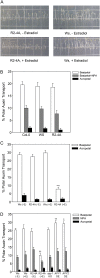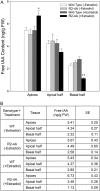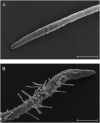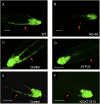Role for apyrases in polar auxin transport in Arabidopsis
- PMID: 23071251
- PMCID: PMC3510125
- DOI: 10.1104/pp.112.202887
Role for apyrases in polar auxin transport in Arabidopsis
Abstract
Recent evidence indicates that extracellular nucleotides regulate plant growth. Exogenous ATP has been shown to block auxin transport and gravitropic growth in primary roots of Arabidopsis (Arabidopsis thaliana). Cells limit the concentration of extracellular ATP in part through the activity of ectoapyrases (ectonucleoside triphosphate diphosphohydrolases), and two nearly identical Arabidopsis apyrases, APY1 and APY2, appear to share this function. These findings, plus the fact that suppression of APY1 and APY2 blocks growth in Arabidopsis, suggested that the expression of these apyrases could influence auxin transport. This report tests that hypothesis. The polar movement of [(3)H]indole-3-acetic acid in both hypocotyl sections and primary roots of Arabidopsis seedlings was measured. In both tissues, polar auxin transport was significantly reduced in apy2 null mutants when they were induced by estradiol to suppress the expression of APY1 by RNA interference. In the hypocotyl assays, the basal halves of APY-suppressed hypocotyls contained considerably lower free indole-3-acetic acid levels when compared with wild-type plants, and disrupted auxin transport in the APY-suppressed roots was reflected by their significant morphological abnormalities. When a green fluorescent protein fluorescence signal encoded by a DR5:green fluorescent protein construct was measured in primary roots whose apyrase expression was suppressed either genetically or chemically, the roots showed no signal asymmetry following gravistimulation, and both their growth and gravitropic curvature were inhibited. Chemicals that suppress apyrase activity also inhibit gravitropic curvature and, to a lesser extent, growth. Taken together, these results indicate that a critical step connecting apyrase suppression to growth suppression is the inhibition of polar auxin transport.
Figures






References
-
- Barkawi LS, Tam Y-Y, Tillman JA, Normanly J, Cohen JD. (2010) A high-throughput method for the quantitative analysis of auxins. Nat Protoc 5: 1609–1618 - PubMed
-
- Benková E, Michniewicz M, Sauer M, Teichmann T, Seifertová D, Jürgens G, Friml J. (2003) Local, efflux-dependent auxin gradients as a common module for plant organ formation. Cell 115: 591–602 - PubMed
-
- Bennett T, Scheres B. (2010) Root development: two meristems for the price of one? In MCP Timmermans, ed, Plant Development: Current Topics in Developmental Biology, Vol 91. Elsevier Academic Press, San Diego, pp 67–102 - PubMed
Publication types
MeSH terms
Substances
Grants and funding
LinkOut - more resources
Full Text Sources
Molecular Biology Databases

